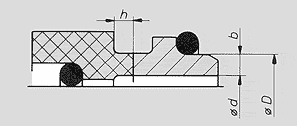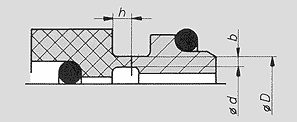| Sliding face | ||
The contact surface of the rotating and stationary sealing ring is referred to as the sliding or sealing face. In axial mechanical seals it is an extremely flat, precision lapped or ground face subject to more or less wear (depending on the design, the material used and the operating conditions) and to various deformations caused by the action of force, pressure and temperature. In addition to standard sliding faces of assorted widths, there are also specially structured sliding faces, e. g. with thermohydrodynamic circulation slots or with annular slots and borings to improve cooling and lubrication, not to mention radial slots (across the sliding face) to increase leakage for rinsing away deposits. Sliding faces with edge tapering (convex shape of sliding face) are often used for high-duty seals. Standard and narrow sealing faces predominate in the series range. D = Outer diameter of sliding face d = Inner diameter of sliding face b = Sealing width
|
h = Wearing height (with heavily wear prone materials h is 2 to 3 mm, with hard materials 1 to 1.5 mm is enough) dm = Mean diameter of sliding face
A = Area of sliding face A = A = (b + d) b p Narrow sealing widths find application when the intention is to reduce power consumption and leakage. The running-in phase is then shortened as well. Generally it is not advisable to make any additional alterations to such narrow faces. Lubrication and circulation slots should be worked into wider sliding faces only. |
|
 Standard sealing face (b » 2 to 12 mm) |
 Narrow sealing face (b » 1 to 5 mm) |